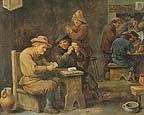
David Teniers the Younger was born in Antwerp in 1610, the eldest son of David Teniers I the Older (1582-1649) of whom he was his pupil.
He also was reportedly the pupil of Peter Paul Rubens and of Adrian Brouwer but no document purporting such assertion has been found yet. However, he started to work painting genre scenes as well as landscapes under the influence of Brouwer and of de Momper round 1632.
His experienced some difficulties during his early years probably because of the financial problems incurred by his father. But as soon as 1633, he became a master of the Guild of Antwerp and received many orders.
On July 4th 1637 he married Ann Brueghel, the daughter of the famed artist Jan Brueghel, who brought him a comfortable dowry and a revenue. Her father also enabled Teniers to meet Rubens. The couple had five children, two sons and three daughters.
After 1647, the Grand Duke Leopold, governor of the Low Counties, became Teniers' patron and attached him to his court as an official painter and also as a chamberlain and curator of his art gallery.
The Grand Duke sent several of Teniers' paintings to many European monarchs and princes as gifts and the artist also became the recipient of many orders, including those of made King Philippe IV of Spain. There were so many of his paintings sent to the Spanish court that a gallery had to be built to house them.
William of Orange and Queen Christine of Sweden were among the other purchasers of his paintings. At the same time Teniers the Younger produced over 200 paintings copied after the works of old masters.
Don Juan of Austria, who succeeded the Grand Duke Leopold in 1656, was a great admirer of Teniers and kept him as a member of his household. Meanwhile, Teniers had left Antwerp for Brussels in 1650 shortly after the death of his father. Ann Brueghel died in May 1656 but Teniers did not stay a widower for long as he married Isabelle de Fren a few months later.
In 1662 he bought from Jan-Baptist Broeckoven and Helene Fourment, Rubens' second wife, the castle of Dry Torens, near Vilvoorde and made it his summer residence. A year later, he took an active part in the setting up of the Antwerp Academy of which he became its first head. He then asked to be accepted as a member of the Flemish nobility but was asked in return not to accept money any longer for his future works. It seemed that he thus gave up the idea of belonging to the gentry.
His last years were marred by illness and sorrow. His second wife died in 1683 and the children of his first marriage sued him in a trial which lasted well after his own death. Teniers produced a large quantity of paintings as over 1,000 have been listed so far. One should however remember that he started his career at a young age and lived until the age of 80. In addition, he was much prolific and often only needed a day to complete a work.
Teniers was also much copied, notably by his pupils such as David Ryckaert III, Thomas Apshoven, Gillis van Tilborch, Matthys van Helmont, François Duchatel, Abraham and David Teniers III, Gillis van Bolder or Jan de Froey. His imitators were Balthasar Beschey, P. de Bloot, A ? Diepraam, Cornelis Safteleven, Hendrick Sorgh and A. de Waes. Many painters of the 18th or 19th century also painted in his manner. Teniers' paintings are now worth on the market between US $ 30,000 for small formats and over US $ 1 million for major works.